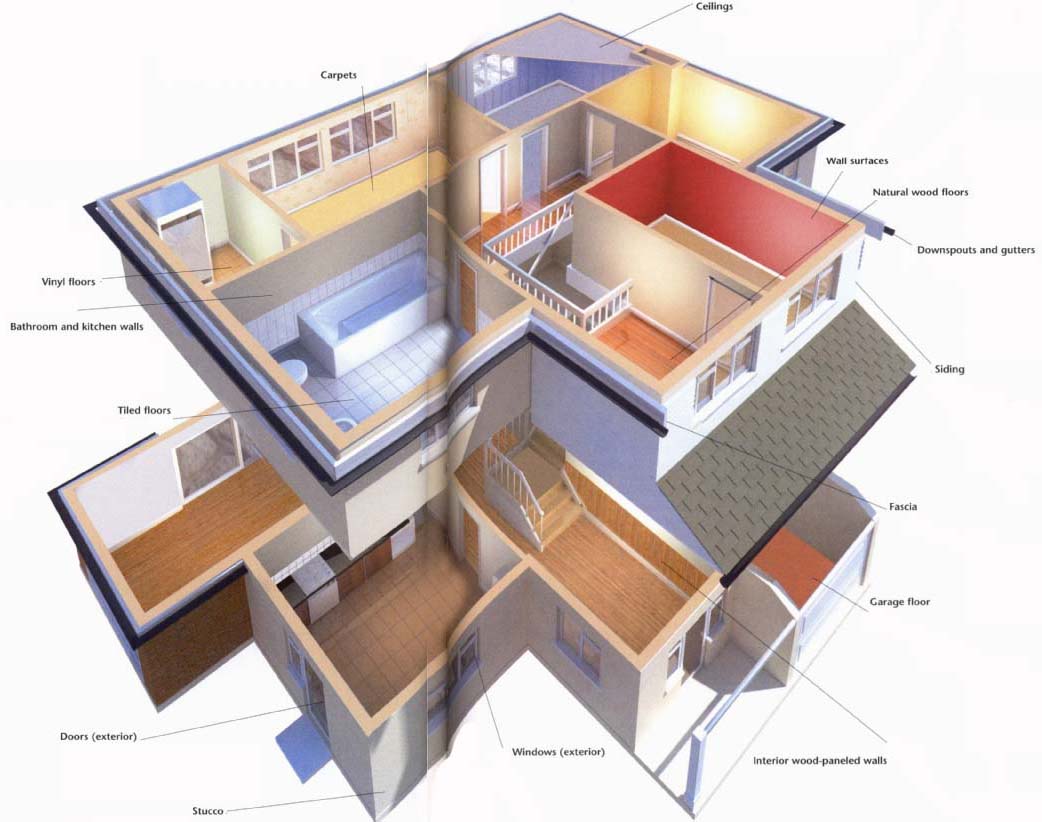DESIGN STYLE
The appearance of your home is, of course, a matter of personal taste,
but there are some general issues that are always worth bearing in
mind. Consider the age and style of the house’s exterior, the shape and size of the rooms, the design of any fixtures such as kitchen cabinets
or a bathroom suite and other aspects that you either can't change,
or do not plan to. Bear in mind the amount of natural and artificial
light available, and remember that dark colors will tend to make a
room seem smaller, while light colors can make it look larger. If you
plan to use two or more strong colors in the same room, consider carefully
whether they go together. In a historic home, you may want a decorative
scheme appropriate for its age, perhaps with brass fixtures and hardware.
Or, if appropriate, you may want a bold modern approach with stone and stainless steel.

Carpets: Comfortable and warm underfoot, carpet is
ideal for most rooms apart from kitchens and bathrooms. In a bathroom,
some people like the feel of carpet, but in practice it can become
damp and therefore rot if the appropriate ventilation isn't present.
Good-quality underlayment increases durability, adds soundproofing, and provides extra comfort.
Vinyl floors: Whether in tiles or sheet form, vinyl
is ideal for “wet” areas in the home like bathrooms and kitchens. It
is waterproof and easy to clean. Linoleum is a more “natural” alternative
to vinyl that achieves a similar finish.
Tiled floors: Ceramic floor tiles are commonly found
in kitchens and bathrooms, and offer a very hard-wearing, easily cleaned
flooring option.
Bathroom and kitchen walls: Wall tiles are commonly
used in kitchens and bathrooms to provide durable, easily cleaned decorative
surfaces. Wallpaper used in these rooms should be of a vinyl variety.
Paints that contain vinyl are also ideal as they provide a good wipe-clean
surface. Some manufacturers will also provide paint that's recommended
for bathroom and kitchen use.
Doors (exterior): The treatment for exterior door
surfaces is much the same as for windows. Making sure that the top
edge and the underside of the door are painted or treated will increase
the life expectancy of the door considerably.
Stucco: Painted stucco will last for up to 10 years
before it requires recoating. Only exterior emulsion or masonry paint
should be used. Other masonry surfaces, such as brick or stone, can be
painted, but these are more often left with their natural finish, since
paint will take to some types of brick or stone better than others.
Ceilings: Most ceilings can have paint applied directly,
or be given a textured finish and then painted. You can often apply
lining paper over rough ceilings to provide a smoother surface for
decoration.
Wall surfaces: Internal drywall can be painted or
covered with wallpaper, depending on design preference. Different types
of paint can provide varying durability, in terms of finish. Water-based
paints such as latex are best suited to wall and ceiling surfaces.
This is also the case for wallpaper.
Natural wood floors: If the existing floorboards
are used as a design finish in their own right, natural wood floors
can be an integral part of your home. Alternatively, a natural wood
floor can be laid on existing concrete, floorboards, or any other type
of boarded floor. In a similar way, modern laminate floors can also
be laid in most areas of the home.
Downspouts and gutters: Vinyl gutters only need to
be cleaned, although they may be painted if required. Metal (ferrous)
gutters require periodic painting to prevent rust and keep them in
good condition. Special metal paints are ideal for this purpose.
Siding: This may be painted, or, if wooden, given
a natural finish. Vinyl and aluminum-based siding only requires washing,
but it can be painted using special systems. Cement-based siding is
normally supplied pre-finished, and this may also be painted if required.
Fascia: Wooden fascia boards are either painted or
have a natural wood finish applied. They should be painted at the same
time as windows and doors. They may also be exchanged for, or covered
with, vinyl alternatives, which only require cleaning rather than painting.
Garage floor: Floor paint is ideal for concrete floors,
such as those commonly found in garages. It is hardwearing, has some
visual appeal, and is easily cleaned. New concrete floors must be allowed
to dry out completely before paint is applied.
Interior wood-paneled walls: Paneled walls are best
painted or given a natural wood finish. Interior-specified coatings
will provide the best finish.
Windows (exterior): Wooden windows require either
painting or the application of a natural finish. Redecoration should
occur every 3 - 5 years, using only coatings recommended for exterior
woodwork. Vinyl, aluminum, and wood composite windows are best treated
by regular washing. |